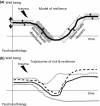Resilience in mental health: linking psychological and neurobiological perspectives
- PMID: 23488807
- PMCID: PMC3746114
- DOI: 10.1111/acps.12095
Resilience in mental health: linking psychological and neurobiological perspectives
Abstract
Objective: To review the literature on psychological and biological findings on resilience (i.e. the successful adaptation and swift recovery after experiencing life adversities) at the level of the individual, and to integrate findings from animal and human studies.
Method: Electronic and manual literature search of MEDLINE, EMBASE and PSYCHINFO, using a range of search terms around biological and psychological factors influencing resilience as observed in human and experimental animal studies, complemented by review articles and cross-references.
Results: The term resilience is used in the literature for different phenomena ranging from prevention of mental health disturbance to successful adaptation and swift recovery after experiencing life adversities, and may also include post-traumatic psychological growth. Secure attachment, experiencing positive emotions and having a purpose in life are three important psychological building blocks of resilience. Overlap between psychological and biological findings on resilience in the literature is most apparent for the topic of stress sensitivity, although recent results suggest a crucial role for reward experience in resilience.
Conclusion: Improving the understanding of the links between genetic endowment, environmental impact and gene-environment interactions with developmental psychology and biology is crucial for elucidating the neurobiological and psychological underpinnings of resilience.
© 2013 John Wiley & Sons A/S. Published by John Wiley & Sons Ltd.
Figures


References
-
- Sapienza JK, Masten AS. Understanding and promoting resilience in children and youth. Curr Opin Psychiatry. 2011;24:267–273. - PubMed
-
- Castleden M, McKee M, Murray V, Leonardi G. Resilience thinking in health protection. J Public Health (Oxf) 2011;33:369–377. - PubMed
-
- Zautra AJ, Hall JS, Murray KE. Resilience: a new definition of health for people and communities. New York: The Guilford Press; 2010.
Publication types
MeSH terms
LinkOut - more resources
Full Text Sources
Other Literature Sources
Medical

